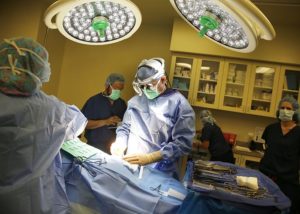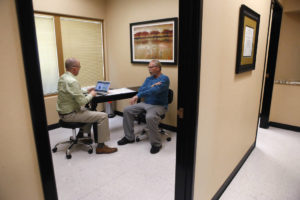Peripheral nerve surgery offers relief from chronic pain
By PAUL HARASIM
LAS VEGAS REVIEW-JOURNAL
Updated April 30, 2017 – 9:20 pm
An accident nearly turned Jason Russo into a drug addict as he tried to blot out the pain in his leg.
Robert Jackson had to use powerful narcotics after accidents tore up his back.
A balky knee was behind Navy veteran Mark Kline’s heavy drug use.
An explosion set off in 2006 by the Taliban in Afghanistan generated medical treatments that would leave Army veteran Fran Schultz in such excruciating pain that he increasingly turned to prescription opiates, which left him in a daily, desensitized stupor.
All four men say Henderson’s Dr. Tim Tollestrup, a peripheral nerve surgeon, is the reason they no longer need addictive painkillers.
Schultz, whose hip area was mangled after his Humvee was blown up, goes even further.
“I’m probably only alive today because of him,” the Las Vegan says. “Without his surgery, I think I would have committed suicide. … My wife was doing everything for me. I couldn’t even go to the bathroom by myself.”
Tollestrup attributes his training in peripheral nerve surgery for giving the men a quality of life that they thought they’d never experience again.
His mentor, Dr. A. Lee Dellon of the Johns Hopkins University School of Medicine, is credited by the medical community with developing most of the modern surgical techniques in the specialty. He founded the Dellon Institutes for Peripheral Nerve Surgery in Maryland in 2000 and began a fellowship training program in 2002.
New Surgical Field

Dr. Tim Tollestrup helps patients with nerve surgery in Southern Nevada.
“In the U.S., there are roughly nine or 10 doctors who have had the training,” notes Tollestrup, who settled in Henderson because he had family in the area. “We are essentially witnessing the dawn of a brand new field of surgery. … Most doctors are unaware of it. … In 50 years, this type of surgery will be as accepted and commonplace as orthopedic or any other type of surgery that we are familiar with in 2017.”
The peripheral nervous system, which encompasses all the nerves in the human body outside of the skull and bony spine, sends signals to the brain, which is how people experience pain. Tollestrup says he can often pinpoint the source of a patient’s pain by identifying damaged, pinched or stretched nerves.
Because imaging studies do not reveal most nerve problems, Tollestrup combines a physical examination with his knowledge of peripheral nerve anatomy to make a good diagnosis.
“(It) allows me to identify the injured nerve and formulate an appropriate surgical procedure to correct the problem,” he says. “Once I’m inside I can see a nerve is swollen or larger than normal … another abnormality is that the nerve becomes infiltrated with fat tissue.”
Sometimes he must improvise once a procedure is underway — Tollestrup does not deny the art in what he does.
Either through peripheral nerve decompression — where he creates space for nerves to function properly — or by segmental denervation, which involves cutting a nerve to interrupt the pain response, Tollestrup says he is often able to eliminate chronic pain.
“I love the intellectual challenge … the way I can … change peoples’ lives for the better, often dramatically.”
‘Miracle Worker’
Russo, who suffered a devastating, twisting injury to his right knee three years ago while working out with a friend in his Kingman, Arizona, home, calls Tollestrup “a miracle worker.”
Even though he had undergone a seven-hour surgery by an orthopedist to correct torn ligaments, the pain in his leg became so severe that he moved temporarily into a trailer on the back of his family’s property. His screams made it impossible for his wife and children to sleep.
While prescription pain medication eventually enabled him to move back into his house, he lost his job as a miner and couldn’t communicate well with family and friends.
“The pain medication basically kept me in a coma, so I couldn’t work or do anything other than lay around,” Russo recalls. “I was told by a pain management doctor that I’d just have to learn to live with the pain.”
He was diagnosed with complex regional pain syndrome, or CRPS. After more than two years without any progress in his condition, Russo talked with a podiatrist who speculated he might have a nerve problem. That doctor gave him contact information for Tollestrup.
“The vast majority of CRPS patients are just people who have one or more injured peripheral nerves, which no one has been able to diagnose,” Tollestrup says. “It required two separate operations to address all of the nerve pathology in Jason’s right leg. The operations basically consisted of multiple nerve decompression surgeries.”
The procedures, one in late 2016 and one early this year, have essentially made Russo pain free.
“I’m working in a pipe yard loading trucks,” he says. “It’s a miracle. I’m fine.”
Long road to relief
Jackson’s back pain from wakeboarding and four-wheeler accidents in the past couple of years and Kline’s mystery knee pain were initially misdiagnosed as needing orthopedic solutions, Tollestrup says.
He adds that both Jackson, a manager for John Deere, and Kline, a retired Navy veteran, had surgeries they didn’t need — Jackson, an unnecessary spine procedure, and Kline, an unneeded knee replacement.
“The reason that Robert did not get better with the spine surgery is that both his low back pain and the sciatica pain were due to peripheral nerve problems,” says Tollestrup, who surgically decompressed nerves in his right leg and disconnected nerves in Jackson’s back that did not have function in moving muscles.
“It was amazing that pain I had lived with for so long was all gone,” Jackson says.
Tollestrup also found out Kline had peripheral nerve damage in his knee area.
“I’m glad he got me out of pain, but that damn knee replacement — my pain only got worse from it,” Kline says.
Firm Believer
Years of worsening pain — Schultz says trips to Veterans Affairs hospitals for procedures only made him worse — left the former sergeant holed up in his bedroom taking painkilling drugs that put him in a stupor, unable to work as a trucker or play with his kids.
Last year, his wife discovered Tollestrup’s website.
When Schultz described his symptoms to Tollestrup, the surgeon immediately knew what to do. A small muscle in the buttocks compressing the sciatic nerve was removed.
Two other procedures relieved pressure on the same nerve in the calf and on top of the foot.
“The pain went away just like that,” Schultz says. “This country definitely needs more nerve surgeons.”
Contact Paul Harasim at pharasim@reviewjournal.com or 702-387-5273. Follow @paulharasim on Twitter.
https://www.reviewjournal.com/life/health/peripheral-nerve-surgery-offers-relief-from-chronic-pain/

